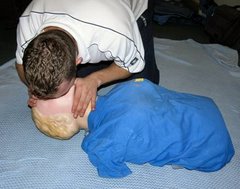Rescue Breathing
If the casualty is not breathing by themself you need to breathe for them. This is achieved by giving rescue breaths (commonly known as mouth to mouth).
GO AND GET HELP, if it isn't already on the way, as soon as you know the casualty is not breathing. There is an exception to this rule - if you suspect the casualty is not breathing due to injury, choking or drowning give them 5 rescue breaths and 30 chest compressions before going for help.
Once help is on the way:
- Give 30 chest compressions as described in the 'Chest Compressions' lesson.
- Give 2 rescue breaths as follows:
- Ensure the casualty's airway is kept open (head tilted back and two fingers lifting chin) throughout.
- Pinch the soft part of the casualty's nose with your finger and thumb. Keep the chin lifted with your other hand.
- If you have a face shield or pocket mask place it over the casualty's mouth. If not carry on without hesitation.
- Take a breath and place your mouth over the casualty's. Maintaining head tilt and chin lift blow steadily until the casualty's chest rises. This should take about 1 second.
- Remove your mouth and look along the casualty's chest, which should fall again.
- Give a second rescue breath and then give 30 chest compressions.
- Continue to give rescue breath/chest compression cycles until help arrives, the casualty starts to breathe again or you become too exhausted to continue.
If the chest doesn't rise during your rescue breath:
- Adjust your position, check the casualty's airway is open and clear and attempt a further 2 rescue breaths.
- If, after the 2 attempted rescue breaths, you are still unsuccessful give 30 chest compressions without delay.



